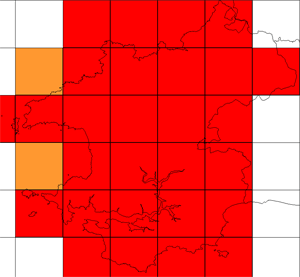Breeding resident, passage migrant and winter visitor
Both Mathew (1894) and Lockley et al. (1949) described the Blackbird as a common resident, the former commenting on a rapid increase in numbers following mild winters. Blackbirds still breed commonly throughout Pembrokeshire, including some of the offshore islands (see map). The encroachment of conifer plantations on the slopes of the Preseli Mountains has enabled them to breed at higher altitudes than before, but they are still absent from the open tops. At an average density of 100 pairs per tetrad, the total breeding population is probably about 45,000 pairs.
Some are resident, which can be confirmed by noting distinctly marked birds, such as partial albinos, staying in territory throughout the year. However, they generally become sparse in late August and early September, a time when it would be reasonable to expect high numbers, with juveniles present as well as adults. Although less conspicuous during moult a careful search seems to indicate a genuine reduction in numbers. It is probable that many leave the county, perhaps emigrating, though we have no proof of this. The appearance of a Blackbird at the Smalls on 18 July 1982 is interesting in this context, but extensive ringing of Pembrokeshire nestlings may be the only way to put speculation to the test.
Thousands pass through between late September and early December, passage being strongest in October and early November. They are heard calling at night and large numbers have been noted at the lanterns of the South Bishop and the Smalls lighthouses. Periodic falls occur around the coast and on the offshore islands, numbers sometimes being impressive; for example, 11,000 were seen at Skokholm on 18 October 1964. Ringing recoveries show that some of these migrants originated in England on an arc from Stafford to North Devon, whilst others came from western Europe, from between Belgium and Norway. Recoveries also show that Blackbirds passing through Pembrokeshire carry on southwards as far as Spain. In addition, they have been seen at sea heading for Ireland.
Blackbirds may well be more numerous during the winter than in the summer, particularly during mild years. Some are continental birds, such as one ringed in Holland in October and recovered at Pembroke Dock in late December. Further influxes occur when cold weather grips Europe and eastern Britain. Many pass on but others stay until they can retreat eastwards again after the thaw. If the severe weather reaches Pembrokeshire, and endures for any length of time, many die, though there have been no modern repetitions of events such as those noted by Lockley et al. (1949), when thousands of birds perished and the beaches became lined with the corpses of Blackbirds and other "soft- billed birds".
There is a return passage in late February and throughout March, when they are again heard passing at night and have been detected at the lanterns of the South Bishop and Smalls lighthouses.

Fieldwork 1984-88 (based on 478 tetrads)
Red = breeding confirmed = 299
Orange = breeding probable = 133
Yellow = breeding possible = 19
Total tetrads in which registered = 451 (94.4%)
Donovan J.W. & Rees G.H (1994), Birds of Pembrokeshire
Although the 1994 avifauna says that 11,000 Blackbirds were on Skokholm on 18th October 1964, the island log says “c,1,000” so the entry is a typographical error. Still a good number for the island and one of the highest counts for anywhere in Wales.
 Monday, August 12, 2013 at 7:34AM
Monday, August 12, 2013 at 7:34AM 





